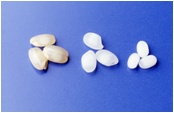The range and quality of sake is largely determined by the rice-polishing ratio, variety of rice, variety of yeast and alcohol percentage. Depending on these factors, sake may be fruity or full-bodied, dry or sweet. When labeling sake, classification is determined by the rice-polishing ratio, brewing technique, ingredients or a combination thereof.
Rice -Polishing Ratio
| Rice-Polishing Ratio | Characteristics | |
|
Daiginjo (-shu) |
50% or less |
Ultra-premium sake slowly fermented at low temperatures. Delicate aroma and mild flavor. |
|
Ginjo (-shu) |
60% or less | Premium sake carefully fermented to create a refreshingly fruity aroma and mild flavor. |

Rice-polishing ratio
Left: Brown Rice
Center: 70%
Right: 50%
Daiginjo or Ginjo brewed without additional alcohol are called Junmai Daiginjo or Junmai Ginjo.
Ingredients
| Ingredients | Characteristic | |
|
Junmai(-shu) |
Rice and Water |
Literally “pure rice sake”, junmai is made only from rice and water. Using these ingredients, the junmai category includes a wide variety of sake styles, from light and mild, to rich and full-bodied. |
|
Honjozo(-shu) |
Rice (polished to 70% or less), water and limited brewer's alcohol | Literally “formal brew sake” (in comparison to futsu-shu), honjozo sake is made from rice polished to at least 70%, water, and a small addition of brewer's alcohol. This addition of alcohol is a traditional technique for creating a clean and mild-tasting sake. |
|
Futsu-shu |
Rice (not specified), water and brewer's alcohol | Literally “ordinary sake”, futsu-shu is the most common type of sake in Japan, and contains a small percentage of brewer's alcohol but does not have a specifically determined rice-polishing ratio or brewing method. Futsu-shu is sold mainly in Japan but is exported to a limited number of other Asian countries. |
Brewing Technique
| Special Technique | Characteristic | |
|
Nama Sake |
Unpasteurized | Contemporary, unpasteurized “draft sake.” Immediately after fermentation is complete, this sake passes through ultra-micro filters and is bottled unpasteurized. This process results in giving nama sake its fresh, fruity fragrance and smooth character. |
|
Namachozo-shu |
Pasteurized only once | Literally means "fresh storage". Regular pasteurized sake is usually heated twice: once before maturation, and once again before bottling. Namachozo sake is matured in a "fresh" state, and pasteurized only once before bottling. This sake style is typified by its mellow flavor and fresh nama sake-like aroma. |
|
Nigori Sake |
Roughly filtered | Literally “cloudy sake”, nigori sake is roughly filtered after fermentation is finished and rice texture from the moromi remains. Nigori has a white and milky appearance. |
|
Koshu |
Extra aging for years | Aged sake made through a maturation process requiring more than three years to complete. This sake is best known for its fine harmonization of complex aromas and deep flavors. Possessing a favorable bitterness and pleasant lingering taste, ko-shu is reminiscent of sherry. |
Changes in consumer tastes and advancements in brewing technology have made it possible for the diversification of sake varieties. Combining rice-polishing ratios with new brewing methods have made it possible to develop such new sakes as Junmai Nama Sake and Ginjo Ko-shu.
